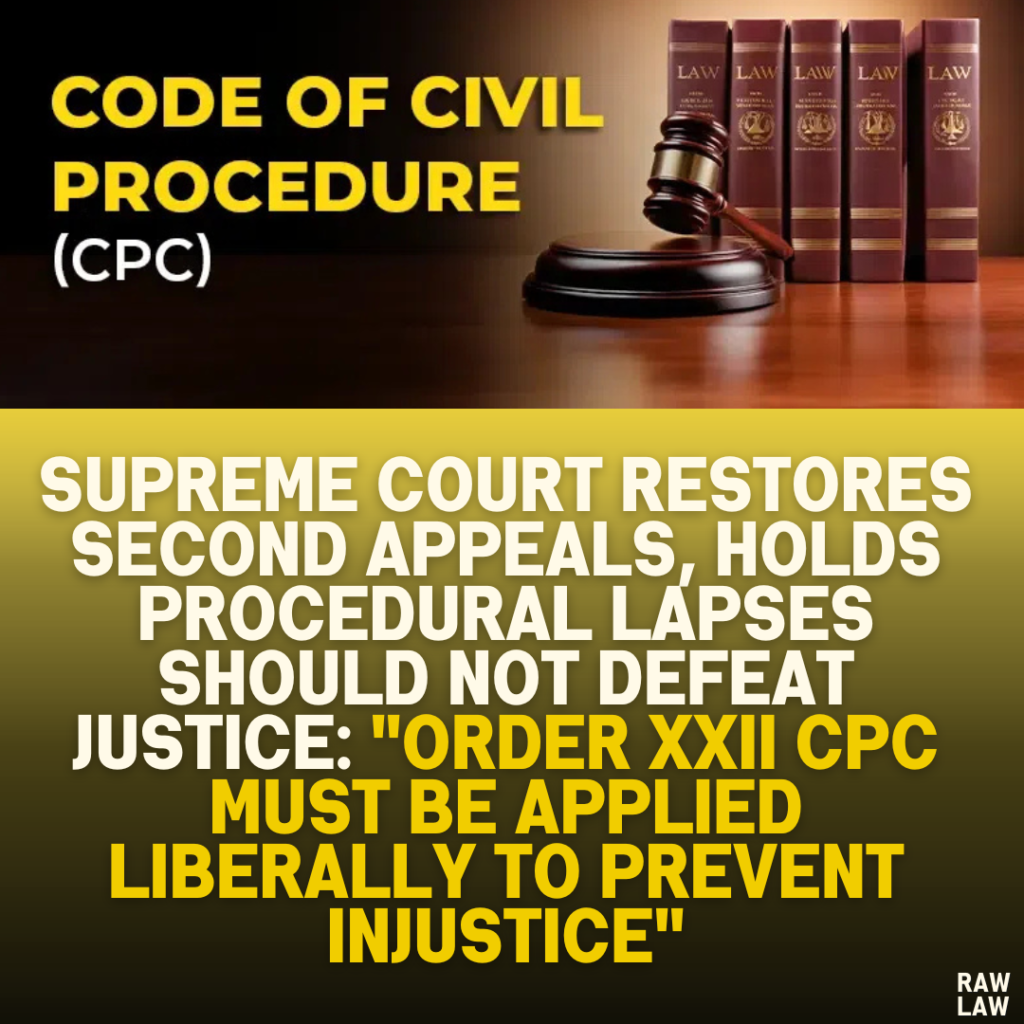Court’s Decision
The Supreme Court allowed the appeals, set aside the High Court’s orders, and restored the second appeals. It clarified that procedural technicalities should not prevent justice from being delivered. The Court directed the High Court to prioritize these second appeals and resolve them within six months due to their prolonged pendency.
Facts of the Case
- Civil Appeal No. 13407 of 2024:
- Background: Satish Chandra had filed a suit in 1972 for the specific performance of an agreement to sell dated February 8, 1970. While the trial court dismissed his suit, the first appellate court decreed it in his favor in 1977. Om Prakash filed a second appeal in the High Court in 1977.
- Procedural Timeline:
- Satish Chandra passed away in 1996, and his heirs applied for substitution in 1997.
- Om Prakash passed away in 2001. His heirs failed to file substitution applications for many years.
- In 2007, the High Court declared the second appeal abated due to the absence of substitution applications by Om Prakash’s heirs.
- In 2018, Om Prakash’s heirs sought to set aside the abatement and restore the second appeal. However, the High Court dismissed their application.
- Civil Appeal No. 13408 of 2024:
- Background: Rooprani, wife of Satish Chandra, had filed a separate suit for specific performance of another agreement in 1973. Her suit followed a similar procedural trajectory—dismissed by the trial court, decreed in her favor by the first appellate court, and challenged in a second appeal by Om Prakash.
- Procedural Timeline:
- Rooprani passed away in 1991. Om Prakash’s counsel was allegedly informed of her death through an affidavit filed by her son in 1992.
- Om Prakash himself passed away in 2001. His heirs failed to take timely steps for substitution, resulting in the second appeal being dismissed for non-prosecution in 2006.
- In 2018, Om Prakash’s heirs sought restoration of the second appeal and condonation of delay. However, the High Court dismissed these applications, citing negligence.
Issues
- Whether the High Court was justified in treating the second appeals as abated due to procedural lapses.
- Whether the substitution applications and delay condonation applications filed by Om Prakash’s heirs were valid and should have been allowed.
Petitioner’s Arguments
- Om Prakash’s heirs argued that procedural rules under Order XXII of the CPC should not override substantive justice.
- The substitution applications filed by Satish Chandra’s and Rooprani’s heirs had already notified the court of their deaths, making further substitution applications unnecessary.
- The delay in filing substitution applications should be condoned to prevent injustice.
Respondent’s Arguments
- Satish Chandra’s and Rooprani’s heirs contended that Om Prakash’s heirs failed to act diligently despite being aware of the deaths.
- They argued that procedural rules must be strictly followed, and the High Court’s orders should not be interfered with.
Analysis of the Law
The Supreme Court undertook a detailed analysis of procedural rules and guiding principles:
- Order XXII of CPC:
- Rule 4 requires substitution of deceased parties within 90 days of their death, failing which the suit or appeal abates.
- However, the Court clarified that either party may file for substitution, and the law does not mandate that only the plaintiff/appellant must do so. The substitution application filed by Satish Chandra’s heirs in 1997 was sufficient.
- Rule 10-A of Order XXII CPC:
- This rule requires lawyers to inform the court of a client’s death and obligates the court to notify the opposing party.
- The Supreme Court found that proper notice was not given to Om Prakash regarding the deaths of Satish Chandra and Rooprani. Hence, the delay in substitution could not be held against Om Prakash’s heirs.
- Limitation Act, 1963:
- Articles 120 and 121 provide 150 days (90 days for substitution and 60 days to set aside abatement) for taking necessary steps after a party’s death.
- The Supreme Court emphasized that delay beyond this period should be condoned liberally unless caused by gross negligence or bad faith.
- Judicial Precedents:
- Perumon Bhagvathy Devaswom v. Bhargavi Amma: Courts must adopt a liberal and justice-oriented approach when dealing with delay and abatement to ensure substantial justice.
- Mithailal Dalsangar Singh v. Annabai Devram Kini: A substitution application can be construed as including a prayer for setting aside abatement.
- Union of India v. Ram Charan: Procedural rules should not obstruct the delivery of justice.
Court’s Reasoning
- Civil Appeal No. 13407 of 2024:
- The Court held that the substitution application filed by Satish Chandra’s heirs in 1997 was valid and sufficient to notify the court of his death.
- Om Prakash’s heirs were not required to file a separate substitution application.
- The High Court’s dismissal of the second appeal as abated was incorrect and based on a misunderstanding of procedural rules.
- Civil Appeal No. 13408 of 2024:
- The Court found that the affidavit filed by Rooprani’s son in 1992 did not clearly inform the court of her death. Hence, Rule 10-A was not complied with, and Om Prakash could not be held accountable for failing to act sooner.
- The abatement of the second appeal was set aside, and the substitution application was allowed.
Conclusion
- The Supreme Court allowed both appeals, set aside the abatement of the second appeals, and restored them for hearing.
- It directed the High Court to prioritize the cases and decide them within six months.
Implications
This judgment reinforces the principle that procedural technicalities should not defeat substantive justice. It underscores the importance of adopting a justice-oriented approach when interpreting procedural laws, especially in long-pending cases. The ruling also clarifies the obligations of parties and courts under Order XXII CPC and emphasizes the liberal condonation of delays to prevent injustice.



